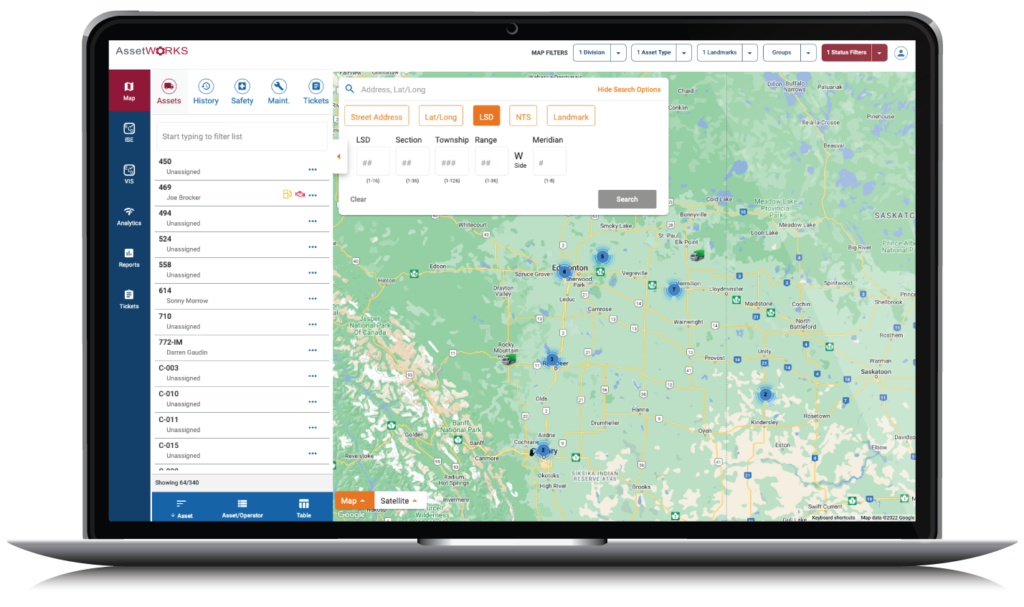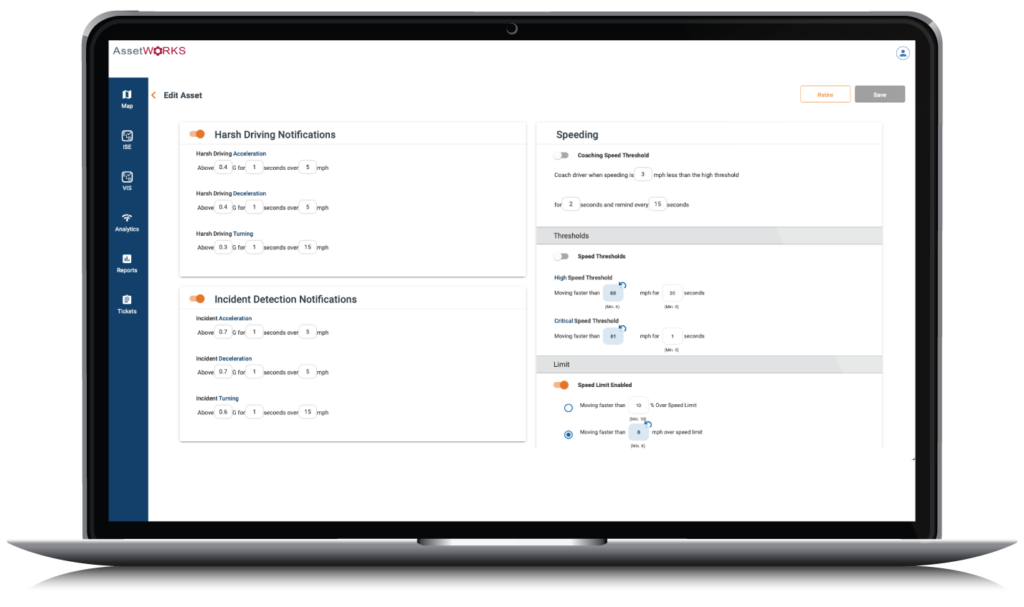The term “telematics” originated in the late 20th century. Telematics combines telecommunications and informatics so fleets can remotely retrieve data related to their vehicles’ location, performance, and status. The technology has become more common in fleets with the rise of the internet and telecommunication networks. Fleets can utilize telematics data to enhance safety and efficiency through real-time vehicle tracking and driver behavior monitoring. Telematics goes beyond vehicle and driver monitoring and can help with decision-making, predictive maintenance, and enhanced customer experiences, making it a useful tool for fleets.
Understanding GPS Fleet Tracking Software
GPS fleet tracking software monitors and manages vehicles or assets in real-time. It provides accurate location data, enabling fleets to track the movements and activities of their vehicles. GPS fleet tracking offers visibility into driver routes, vehicle speed, and idle time- enhancing operational efficiency. Fleet tracking helps optimize fuel consumption, reduce maintenance costs, and improve driver behavior by providing data for analysis, real-time fleet visibility, and actionable information for better decision-making.
Fleet tracking began in the mid-20th century when companies used radio signals to monitor and communicate with their vehicles. Over time, this evolved into systems that relied on cellular networks and satellite technology to transmit location data. The emergence of telematics in the late 20th century marked a significant shift, as it incorporated various data sources like GPS, vehicle sensors, and communication networks to provide comprehensive insights beyond just tracking.
Telematics plays a crucial role in modern GPS fleet tracking by integrating GPS data with vehicle information and real-time communication. Telematics devices capture data, offering a complete view of fleet operations. This data is then analyzed and reported so fleets can make informed decisions to achieve the following GPS tracking benefits:
Improved Safety
Fleet tracking solutions can monitor driver behavior, promoting safer driving habits and reducing accidents and associated costs.Enhanced Efficiency
With route optimization, idle time reduction, and improved maintenance scheduling, businesses can increase operational efficiency and reduce fuel consumption.Cost Reduction
Companies can lower operational costs and improve their bottom line by analyzing data on fuel usage, vehicle maintenance, and driver productivity.

Fleet Telematics
Fleet telematics is a transformative technology that has revolutionized how fleets manage their vehicles. The telematics device combines telecommunications and informatics for remote tracking and management of vehicles in real-time, providing fleets with valuable data on vehicle locations, driver behavior, maintenance needs, and more.
Telematics devices serve various functions in fleet management and vehicle monitoring:
- GPS Tracking
Telematics devices are equipped with GPS technology, allowing real-time vehicle location tracking and routes. - Driver Behavior Monitoring
Telematics monitors driver behavior, including speed, braking, and acceleration, promoting safer driving, and reducing accidents - Fuel Monitoring
Sensors track fuel consumption and detect fuel theft or excessive idling, leading to cost savings and environmental benefits. - AI Dashcams
Fleet want telematics devices with integrative AI dashcams to record driver behavior and provide video evidence in case of accidents or disputes. AssetWorks’ AI Dashcam captures video from dual-facing cameras so fleets can analyze events inside the vehicle and on the road. - Odometer Readings
Telematics devices capture accurate odometer readings, simplifying maintenance scheduling and ensuring accurate mileage reporting. - Route Optimization
Telematics can analyze traffic to provide optimized route suggestions, reducing travel time and fuel consumption.
These functions provide fleet visibility into operations, allowing fleets to enhance efficiency, safety, and cost-effectiveness. The data lets fleets make informed decisions by identifying data trends and detecting operational efficiencies, cost-saving opportunities, and safety improvements. Fleets must leverage these insights to make strategic decisions, such as optimizing routes, scheduling maintenance, and promoting safer driving practices, to improve fleet performance and profitability.

GPS Fleet Tracking Software
GPS fleet tracking software is a digital platform designed to work with GPS hardware installed in fleet vehicles. GPS fleet tracking software compliments the hardware by receiving and processing the data collected by GPS devices. Fleet tracking data enables fleet managers to access critical insights, generate reports, and make data-driven decisions to optimize efficiency- making it a powerful tool to streamline and manage the entire fleet effectively.
GPS fleet tracking software goes beyond data and offers geofencing by using GPS coordinates to create virtual boundaries on a digital map. When a tracked vehicle enters or exits these predefined geographic zones, the system detects it in real time and triggers alerts or notifications to inform fleet managers or system administrators.
AssetWorks GPS is a comprehensive GPS/Telematics software to track and manage vehicles, assets, and drivers. AssetWorks GPS automatically captures data points from light and heavy-duty vehicles, trailers, yellow iron, and other high-value assets. Real-time integration with FleetFocus eliminates manual data collection and streamlines your maintenance processes with accurate and timely data.
AssetWorks GPS captures the following data points:
- Odometer Readings
AssetWorks GPS captures ECM-based mileage to ensure PM schedules get managed effectively. For non-ECM-equipped vehicles, GPS offers a calculated mileage. - Trouble Codes
Real-time capture of trouble codes (DTCs) and Malfunction Indicator Lights (MILs) ensures critical problems can be dealt with promptly. - Vehicle Location Tracking
With regular location updates to FleetFocus, your maintenance staff will no longer waste time. “I used to spend hours on the phone trying to locate my drivers, but with AssetWorks [GPS], I can immediately see where my trucks are and see how close they are to the site rather than just randomly guessing,” said Darryl Enders, Rick’s Oilfield Hauling Supervisor of Operations in a case study. - Capture Engine Hours
AssetWorks GPS captures engine hours directly from ECM or will utilize cumulative engine run time on/off to capture hours to optimize hourly-based PM schedules.
The Role of Real-Time Fleet Tracking in Fleet Management
Real-time tracking in fleet management provides immediate fleet visibility into the location and status of vehicles and assets. It enables fleet managers to do the following:
- Improve Dispatching
Real-time tracking enhances dispatching by providing accurate real-time vehicle locations, enabling dispatchers to assign jobs to the closest available vehicle. - Reduced Response Times
Real-time tracking reduces response times by allowing dispatchers to instantly identify the nearest available vehicle to a service location, ensuring quicker allocation of tasks. This immediate and accurate information enables a more efficient response to customer requests or emergencies, improving overall service and satisfaction. - Enhanced Route Optimization
Real-time tracking enhances route optimization by continually monitoring vehicle positions and traffic conditions, enabling dynamic route adjustments. This flexibility ensures that vehicles take the most efficient paths, reducing travel time and fuel consumption while improving delivery or service times.

Driver Behavior Monitoring
Driver behavior monitoring is significant for fleet management as it directly impacts safety and fuel efficiency. By tracking these behaviors, fleets can promote safer driving practices, reducing their risk of accidents and the costs that come with it:
- Speeding
Telematics tracks speeding by monitoring a vehicle’s speed in real time and comparing it to preset limits. When a driver exceeds set limits, the telematics system generates alerts and reports, allowing fleet managers to identify speeding incidents, address them with drivers, and ultimately promote safer driving behavior. - Harsh Braking and Acceleration
Telematics tracks harsh braking and acceleration by recording sudden and excessive changes in vehicle speed. When detected, telematics systems log these events, providing valuable data to coach and educate drivers on adopting smoother driving habits, reducing vehicle wear, improving passenger comfort, and enhancing overall safety. - Idling
Telematics tracks idling by monitoring a vehicle’s engine when not in motion. This data is collected and can be used to identify excessive idling patterns, which, when addressed, can help improve driver behavior by reducing fuel waste, minimizing emissions, and increasing overall fleet efficiency.
Tracking driver behavior also improves fuel efficiency by encouraging drivers to adopt smoother driving habits, such as avoiding harsh acceleration and braking, which reduces fuel consumption and wear and tear on vehicles, extending their lifespans and contributing to a more cost-effective and sustainable fleet operation.
Implementing Telematics
Implementing telematics into your fleet involves carefully selecting the right vendor, ensuring proper installation and integration, establishing efficient data collection and analysis processes, and focusing on driver training and acceptance to reap the full benefits of GPS tracking:
- Telematics Hardware and Software Selection
When shopping for a telematics solution, ensure the vendor offers a user-friendly platform with real-time tracking, comprehensive reporting, and customizable alerts. The solution should also integrate with existing fleet management software. - Installation and Telematics Integration
Integrating telematics with your existing fleet management software is necessary for data consolidation and complete fleet visibility. A telematics integration streamlines operations reduces data silos and enhances overall fleet management efficiency. AssetWorks GPS integrates with our FleetFocus fleet management software, providing fleets with a powerful platform. - Data Collection and Analysis
Telematics gathers data on vehicle location, speed, and driver behavior. Make the most of telematics data by creating strategy and analyzing telematics data. The data aids in monitoring vehicle health, maintenance planning, and assessing driver performance. - Driver Training and Acceptance
Successful telematics implementation relies on the software and driver acceptance. “Training [on AssetWorks GPS] was simple and quick, and we liked not having a dual system – it was an all-in-one,” said Nick Bauer, Ferus Inc. Logistics Manager in a case study.
Communicate the GPS tracking benefits, such as safety and job security, and offer comprehensive training on telematics devices and software. Emphasize to drivers how telematics can optimize their routes, reduce fuel consumption, and promote safe driving. Fleet managers should also prioritize using the data from their telematics solutions for driver performance reviews to encourage driver acceptance.

Overcoming Common Challenges
Implementing any new solution into operations can come with challenges if not prepared properly. Understanding these challenges and considerations is crucial for making informed decisions and optimizing the use of telematics within your fleet strategy:
- Return on Investment (ROI)
Calculating ROI with telematics can be challenging due to the initial investment, so fleet managers must diligently monitor costs and GPS tracking benefits to calculate their ROI. - Vendor Selection
With diverse GPS tracking devices on the market, thorough research is essential to choose a reputable and dependable provider with a history of delivering on promises. Fleet managers should evaluate vendor support, scalability, and compatibility with existing systems. - Staff Training
Drivers and fleet managers must understand how to operate and interpret the data generated. Fleets must provide training to ensure efficient telematics utilization and address any driver reservations or uncertainties. - Driver Behavior Monitoring
While monitoring driver behavior improves safety and efficiency, drivers may resist if they feel they are constantly under surveillance. Balancing driver privacy and performance monitoring is a challenge that fleet managers must navigate carefully.
Conclusion
GPS tracking can be transformative, offering improved safety, efficiency, and cost savings. To embark on this journey successfully, we encourage fleets to explore cutting-edge solutions like AssetWorks GPS for telematics. AssetWorks GPS is your trusted partner in fleet optimization. Embracing the power of telematics is not just an option; it’s necessary in a world where data-driven insights and operational efficiency are necessary to remain competitive and deliver exceptional service.
Additional Resources
- How Autonomous Vehicles Will Impact the Fleet Industry
Ferus Inc. Case Study - The Reason Fleets Are Investing in AI Dashcams
- The One Step to Grow Revenue and Guaranteeing Customer Satisfaction
- How to Improve Your Telematics ROI
- How to Create a Successful Driver Reward Program
- Rick’s Oilfield Hauling Case Study












